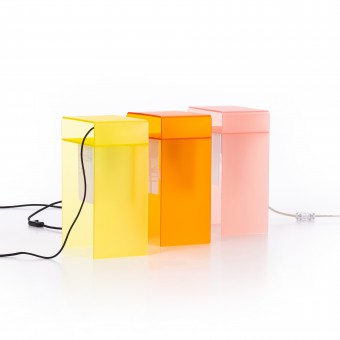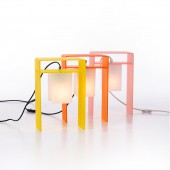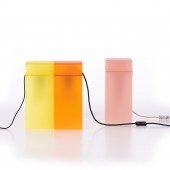
| THE AWARD |
| CATEGORIES |
| REGISTRATION |
| SUBMIT YOUR WORK |
| ENTRY INSTRUCTIONS |
| TERMS & CONDITIONS |
| PUBLICATIONS |
| DATES & FEES |
| METHODOLOGY |
| CONTACT |
| WINNERS |
| PRESS ROOM |
| GET INVOLVED |
| DESIGN PRIZE |
| DESIGN STORE |
| THE AWARD | JURY | CATEGORIES | REGISTRATION | PRESS | WINNERS | PUBLICATIONS | ENTRY INSTRUCTIONS |
U Table Lamp by Mónica Pinto de Almeida |
Home > Winners > Design #144976 >Interview |
 |
|
FS: What is the main principle, idea and inspiration behind your design?
MP: As a designer, my main principle and inspiration behind the U table lamp was to blend art and design, with a focus on color and its emotional impact. I drew inspiration from artists such as Matisse and Josef Albers, as well as the visual effects of stained-glass windows. My goal was to create a lighting piece that compels people to see colors in new ways, using colors to interact with the human perception and to interact with the physicality of the spaces.
FS: What has been your main focus in designing this work? Especially what did you want to achieve?
MP: My main focus in designing the U table lamp was to create a lighting piece that blends art and design, with a focus on color and its emotional impact. I wanted to achieve a balance between the lamp's expressive element, color, and its simple, original aesthetic, achieved through the use of rectangular shapes. Additionally, I aimed to explore the ways in which colors can be used to create different effects, moods, and relationships in spaces. Ultimately, I wanted to create a lamp that compels people to observe colors in different ways, adding character and appeal to any interior space. The lamp's clean aesthetic creates a unique atmosphere, changing perceptions of the environment through the change of shades caused by its own light.
FS: What are your future plans for this award winning design?
MP: I would like to continue researching and developing the design to explore new color palettes, materials, and shapes that can be incorporated into future versions of the lamp. This could include experimenting with different sizes, finishes, and textures to create a more diverse and customizable range of lamps for different interior spaces and preferences.
FS: How long did it take you to design this particular concept?
MP: This particular design took me about a year to develop, which included several experiments with different types of acrylics, different colors, and a deep study of the light I wanted to create in conjunction with the reflections of the colors of the acrylic.
FS: Why did you design this particular concept? Was this design commissioned or did you decide to pursuit an inspiration?
MP: I design this particular concept very much due to my academic studies in mural painting, trompe l'oeil and "grisaille" where perspective and light are of enormous importance, and also due to my passion for color. I decided then, to pursuit this inspiration and to reflect and study in more detail the effect of color and light combined, using as inspiration the great masters of color such as Matisse, Josef Albers, the color studies of Johannes Itten and the ancient and modern works of stained glass.
FS: Is your design being produced or used by another company, or do you plan to sell or lease the production rights or do you intent to produce your work yourself?
MP: This design is currently being produced by me and is part of the collection of my brand Mokki Design
FS: What made you design this particular type of work?
MP: What made me design this type of piece, in particular, is the continuous search to create objects that connect with people, ways to see the world with a scrutinizing eye, ways also to express my preferences and desires, and that is what makes us unique, our language.
FS: Where there any other designs and/or designers that helped the influence the design of your work?
MP: What really influenced me in the design of this piece were great artists in the use of color and light, Matisse, Gaudí, Josef Albers, Johannes Itten and my own environment, which is always full of color.
FS: Who is the target customer for his design?
MP: The target customer for this design is likely to be someone who appreciates the combination of art and design and is interested in unique and expressive lighting pieces for their interior spaces. The design's clean aesthetic and emphasis on color may appeal to those who seek to create a particular mood or ambiance in their living or working spaces. It could be particularly attractive to those who appreciate modern and contemporary design styles.
FS: What sets this design apart from other similar or resembling concepts?
MP: Several factors set the U table lamp design apart from other similar or resembling concepts. Firstly, the design emphasizes the expressive element of color, creating a unique blend of art and design. The lamp is formed by simple rectangular lines in the shape of an inverse u, which gives it a clean aesthetic. Secondly, the use of frost colored acrylic for the larger body and opalescent acrylic for the smaller element creates a graphic effect when the light is on, diffusing light in a harmonious way and adding depth to the visual environment. Thirdly, the design was inspired by the designer's academic background and passions, as well as artists who mastered color and light, resulting in a unique interpretation of these influences and finally this approach ensured that the balance of color, light, and shapes was just right and created a piece that is both beautiful and functional.
FS: How did you come up with the name for this design? What does it mean?
MP: The name of this drawing is very simple, because of its shapes it reminds me of the letter U, inverted, and at the same time it plays with the YOU sound.
FS: Which design tools did you use when you were working on this project?
MP: Working on this project I used computer aided design (CAD) software, watercolors on sketches, prototyping tools, graphic design software and in its production, molded acrylic is used and laser engraving for the logo.
FS: What is the most unique aspect of your design?
MP: Above all I think it is a design that transmits joy due to the colors of the material and its effect on the spaces
FS: Who did you collaborate with for this design? Did you work with people with technical / specialized skills?
MP: For this design I worked together with the specialized team in the acrylic factory, to understand the possibilities that we had in terms of material and its behavior.
FS: What is the role of technology in this particular design?
MP: The role of technology in this design is mainly in helping to visualize the part after the first artistic sketches and drawings have been defined and to create a design scheme that can be easily produced in the factory.
FS: Is your design influenced by data or analytical research in any way? What kind of research did you conduct for making this design?
MP: My design was not influenced by data or analytical research, but rather in the form of inspiration, it came from my passions, academic background, and the work of artists who mastered color and light. The research conducted for this design was focused on studying the effect of light and color through different translucent acrylic sheets and exploring the ways in which colors can be used to create different effects, moods, and relationships in spaces. I’ve also researched the art of stained-glass windows of the Middle Ages and the contemporary approach to this technique, which can be seen in Gaudi-designed church, the Sagrada Familia, in Barcelona, Spain.
FS: What are some of the challenges you faced during the design/realization of your concept?
MP: During the design of this piece there were no great technical challenges, but rather, challenges to achieve the final goal which was to create a design that was functional, aesthetically pleasing and accessible to the intended audience, always in touch with the initial inspiration and always striving to unite art and design.
FS: How did you decide to submit your design to an international design competition?
MP: As a designer, submitting my design to an international design competition can be a fantastic opportunity. It allows me to gain exposure, recognition, and feedback from industry experts and peers. Additionally, it can be a great way to showcase my skills and creativity to a wider audience. Participating in an international design competition can provide me with valuable insights into the latest design trends and techniques, as well as allow me to network with other professionals in my field. The feedback I receive from the judges and my fellow designers can also be incredibly helpful in improving my work and honing my skills. Overall, submitting a design to an international design competition can be an exciting and rewarding experience for any designer looking to grow their career and showcase their talents to the world.
FS: What did you learn or how did you improve yourself during the designing of this work?
MP: Although I already had a strong academic background in color theory, designing the lighting colored piece in acrylic allowed me to apply and expand my knowledge in a practical and creative way. I was able to experiment with different color combinations and techniques to create a visually striking and aesthetically pleasing work of art. Through this project, I further developed my skills as a designer and artist, particularly in the area of acrylic manipulation techniques. Overall, it was a challenging and rewarding experience that helped me to grow both as an artist and as a person, and I am proud of the final result. and that allowed me to closely perceive the effect of color on people.
FS: Any other things you would like to cover that have not been covered in these questions?
MP: Thank you for asking, but I don't have anything additional to cover at the moment. However, if you have any further questions or topics you'd like to discuss, please feel free to ask and I'd be happy to assist you.
FS: Thank you for providing us with this opportunity to interview you.
A' Design Award and Competitions grants rights to press members and bloggers to use parts of this interview. This interview is provided as it is; DesignPRWire and A' Design Award and Competitions cannot be held responsible for the answers given by participating designers.
| SOCIAL |
| + Add to Likes / Favorites | Send to My Email | Comment | View Press-Release | Translations |





